


In construction... ![]()
These pages may contain some large images and a few animations. Please be patient while they load...
The explanation for the cyclic changes on the Moon's appearance in the sky during a lunation (see part III of this section) is very simple. As depicted in the drawing and animation presented below, the Sun-Moon-Earth (or Sun-Earth-Moon) geometry changes constantly during the orbital motion of our satellite. It is true that, as occurs with Earth (blue circle), the Moon (brown circle) always exhibits a hemisphere that is completely illuminated by the Sun (yellow circle). However, from our vantage point here on Earth we will only observe the whole sunlit hemisphere at full-moon, since only at that time there is a proper Sun-Earth-Moon alignment.
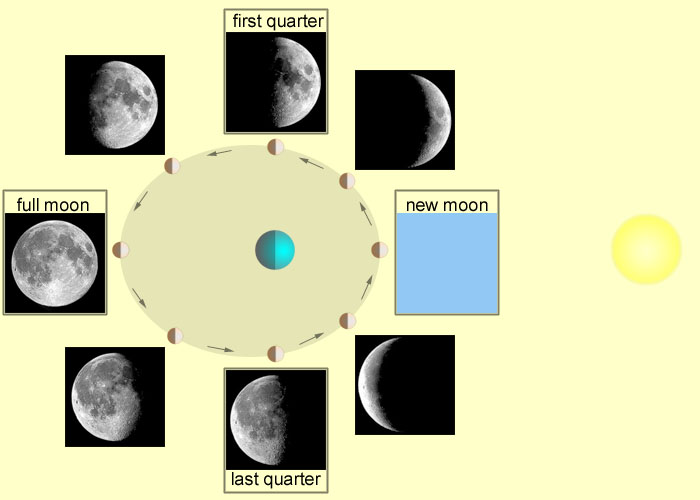
Half a lunation later (or before), the Moon will be in a place along its orbital path that is 180 degrees apart from the previous position. In other words, we will have a Sun-Moon-Earth alignment, and our satellite will only show us the hemisphere that is not illuminated by the Sun. We now speak of new-moon, and due to the scattering effects of our atmosphere upon the sunlight (i.e. our beautiful blue sky), we will not see the Moon at all! Above the atmosphere, and if the Sun could be artificially covered by a mask, we could eventually see a dark-gray moon disk occulting some background stars. But, even in this hypothetical situation, why dark-grey and not pit-black?

As shown in the drawing below (and as well in the above image and animation), the reason for that is just because the Moon's hemisphere that is not illuminated by the Sun, will be so by the Earth's sunlit hemisphere. And the Earth is a very efficient reflector! Not good enough for allowing us to spot the new-moon, since this always occurs during the day (for a given place where the Moon is visible), but it will be very efficient when, a few days later, the Moon will be visible as a thin crescent after sunset. Under these conditions, we will also see the non-sunlit part of the Moon due to the Earth's reflected sunlight. We call this phenomenon earthshine.
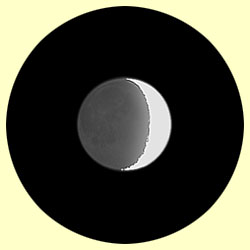
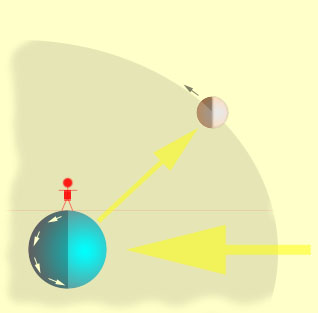
As referred earlier, a Sun-Moon-Earth alignment occurs at new-moon and, in contrast, a Sun-Earth-Moon arrangement takes place during every full-moon. That's our (almost) monthly routine that, with time and "experience", we have a tendency to forget. From time to time, however, such positioning is so perfect (the centers of these three celestial bodies will be in a straight line) that, during new-moon, the Moon's shadow will project itself onto the Earth's surface. If, in turn, such perfect positioning occurs at full-moon, it's our satellite that will be immersed into the Earth's shadow (see animation below). When this occurs we speak of solar and lunar eclipses, respectively (click on images below to see time-lapse animations of real events). In other words, solar eclipses are the demonstration of a perfect new-moon geometry, and lunar eclipses are the equivalent for the full-moon. We may think about solar eclipses in another way, namely as events where our natural satellite, the Moon, occults a star. What happens is that it is not any star that is involved, but our very own star, the Sun! If the occultation is complete we speak of total solar eclipses, and of partial events otherwise. Moon eclipses, either total or partial, may be watched by people from an entire hemisphere. All that is necessary is that the Moon is above the horizon at the correct time. Solar eclipses, in turn, are individually only visible in restrict areas of our planet. The path is surely different for each solar eclipse, but the area where a given event is visible will be very small. These differences are related to the relative sizes of the Earth´s and Moon's cones of shadow, the former being much larger. The area where a solar eclipse is seen as a partial event is less restrict, but the phenomenon will also be less spectacular, since there will be no totality phase. But even if we live in a region of the globe where a given eclipse is seen as partial, there is no reason to despair. Partial solar eclipses are very interesting to follow, and also to understand (more details in the next part of this section). At least, any solar eclipse is the only occasion where there is a chance of observing the new-moon from Earth!

Total Lunar Eclipse Partial Solar Eclipse
As shown in the drawing below, eclipses only occur when the centers of the three celestial bodies are perfectly aligned. That's what occurs at the left part of the drawing. When the Moon is positioned in 1 it will produce a solar eclipse, whereas in 2 the Earth's cone of shadow will determine the occurrence of a lunar eclipse.

In most cases, such a perfect alignment between the Sun, Earth and the Moon does not occur, as depicted in the above drawing at the right (when the new-moon occurs at position 1' there is no solar eclipse, and when full-moon takes place at position 2' no lunar eclipse is observed). Why is it so? Why don't we have eclipses in every full- or new-moon? Simply because the plane of the Moon's orbit is inclined about 5 degrees with respect to the Earth's orbit! In fact, part of the Moon's path is positioned above the plane of the Earth's orbit, while the other part is located below. The Moon's orbit intersects the plane of the Earth's orbit in two points called nodes. The imaginary line that connects these two points in space is called line of nodes (it is shown as a horizontal line spanning the Moon's orbit in the drawing below - the Earth's orbit is shown in red). As you must already have guessed at this moment, eclipses will only occur when the new- or full-moon coincide with the nodes' position. That's what happens in 1 and 2, respectively, but not in 1' and 2'. The below drawing is very simplified though. What happens in reality is that, with time, the line of nodes changes its orientation in space due to perturbations in the Moon's orbit. For instance, the so called regression of the nodes determines that only after about 18.6 years the line will resume its initial orientation in space. Such perturbations establish that eclipses show a repeating pattern of occurrence, called Saros, which lasts approximately 18 years and 11 days. Thus, the bottom line is that eclipses only occur with a favorable Sun-Earth-Moon geometry in space. We know which are such conditions and, therefore, eclipses are explainable and predictable events. There is no place for less rational explanations of its nature and consequences. Of course eclipses are also spectacular events..., and Man is an emotional creature... So, eclipses are also to be enjoyed...
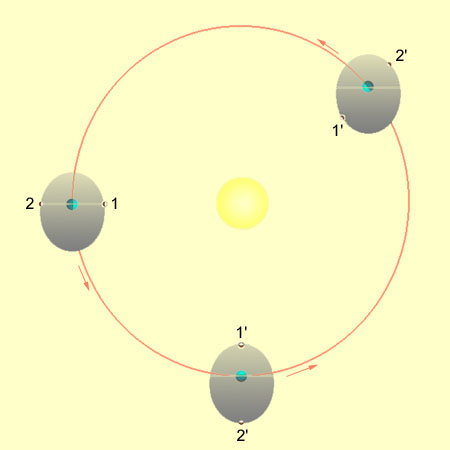
It is common knowledge that the Moon always shows us the same hemisphere, the so called near-side. This derives from the fact that, with time, our natural satellite has synchronized its rotational and orbital periods. In other words, the Moon takes exactly the same time to complete a rotation on its axis and to orbit around the Earth. In consequence of this synchronous rotation, we expect to be able to see only 50% of the Moon's surface. Well..., that's not exactly what happens. We are able to see about 59%... Why? For two main reasons: 1) The Moon's orbit is elliptical, and; 2) the Moon's axis is tilted with respect to the plane of its orbit.
Let's begin with the fact that the Moon's orbit is elliptical. If this is true, then the Earth (to be a little bit more rigorous, the center-of-mass of the Earth-Moon system, which anyway lays below the Earth surface) must be positioned in one of the ellipse's focal points. In consequence the Earth-Moon distance has to vary in a periodic fashion, and that's precisely what happens (the cyclicity corresponds to the Moon's orbital period).
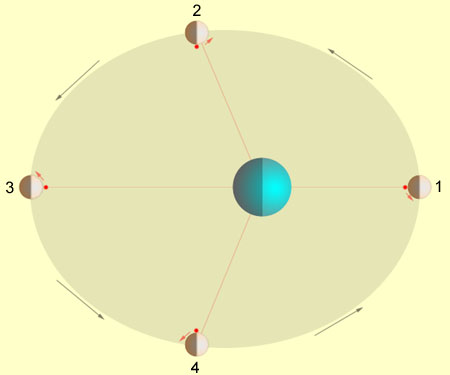
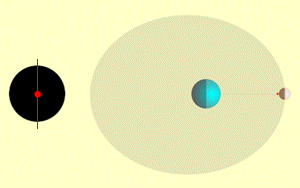
An important cause of the Moon's libration is the fact that its orbit around the Earth is an ellipse


Another important component is libration in latitude. It is due to the fact that the rotational axis of the Moon is tilted with respect to the plane of its orbit. The angle is about 6.4 degrees.

Next section of this page will deal with the issue of what makes lunar and solar eclipses to be either partial or total (sorry, not yet started).
All Images and Texts on these pages are Copyrighted.
It is strictly forbidden to use them (namely for inclusion in other web pages) without the written authorization of the author
© A.Cidadão (1999)
Observation of the MOON Return to the Main Page